 HOME: www.hiltonpond.org |
|||
|
Vaughn Morrison of Todd NC invited us to visit his mountaintop home in Ashe County on 26 October 2003 to trap and band what turned out to be a hatch-year female Rufous Hummingbird. This vagrant hummer had been visiting a feeder and some late-blooming flowers planted by Vaughn's wife, Beth. Vaughn also noted that in the 31 October 2003 edition of a local newspaper (Jefferson Post) he had seen a photo by plumbing contractor/gospel guitarist Darrell Brooks of an adult male Rufous Hummingbird (above right) that had been at the feeder of Ina Mae Brooks--Darrell's mother--on 24-29 September. Vaughn phoned Darrell and learned that Ms. Brooks' hummer had departed with no attempts at banding, but that Darrell--who lives in West Jefferson NC about a half-mile from his mom and ten minutes from the Morrisons--still had at least TWO winter hummers of his own! With the prospect of banding Darrell's two birds and at least one new one at Vaughn's place, we laid plans to stay at the Morrisons' on the evening of 6 November so we could get an early start on our trapping tasks the next day. 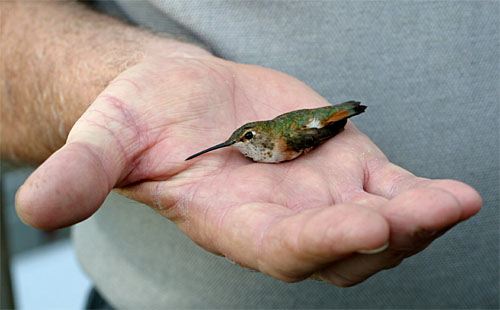
All text & photos © Hilton Pond Center Following some great late-evening conversation with the Morrisons and a good--but short--night's sleep, Vaughn led us down Laurel Mountain in pre-dawn darkness to Darrell's place in West Jefferson. Darrell gets good numbers of Ruby-throated Hummingbirds all summer but noticed in mid-October when this expected species departed it was replaced by birds with rusty-colored bases to their tails. Darrell suspected these newcomers probably were female or young male Rufous Hummingbirds-- the same species he had photographed at his mother's place. Darrell's hummingbird operation consists of several feeders hung along the eaves of a roof that hangs over his second-story deck; he puts in no special plantings to attract birds. Darrell helped us hang our portable trap, and in it we placed the single sugar water feeder he maintains all winter. By then it was 6:15 a.m. and still dark, so we retired to the living room to wait for the sun to come up. At that point Vaughn departed for a day trip with Beth but gave notice we could still go back to their house to check out the two hummers there. 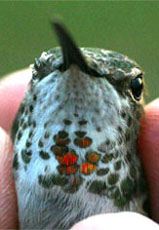 . .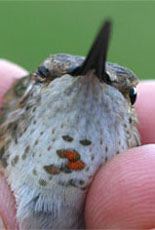 . .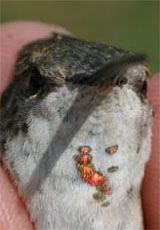
Rufous Hummingbirds Y14850 (left to right), Y14851 & Y14852 By 6:45 a.m. the first hummingbird arrived at Darrell's deck, backlit by the eastern sky as the sun just started peeking over a nearby ridge. The hummer entered the trap rather quickly, so we hit the door-release button and went out to observe it up close. That rusty tail Darrell had seen through binoculars was easily observed; it was indeed a vagrant Selasphorus hummingbird--most likely a Rufous, S. rufus (rather than the somewhat smaller Allen's, S. sasin, a western vagrant seldom seen in the East). Measurements of this bird (#Y14850) confirmed it was a female Rufous, and the general plumage--especially metallic throat feathers (above left & below left)--and lack of tiny bill etchings (corrugations) indicated it was an adult hatched prior to 2003. As we banded this first bird, Darrell kept one eye on the procedure and one on the trap, but no other birds appeared until after we had released #Y148850. It actually didn't take long, however, and at 7:20 a.m. an apparently new hummer that behaved very differently flew near the trap, investigated the trap bottom, and was off like a shot. 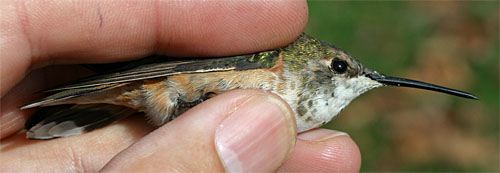
Y14852 Upon arriving, we took down one of Vaughn's two feeders and moved the other inside the trap, which we hung right above a Butterfly Bush (Buddleja davidii) covered with purple flowers and Bumble Bees (below left). In the process we were dive-bombed by a hummingbird whose wing beats sounded very different from those of a ruby-throat, One other hummingbird visited while we watched at the Morrison residence. Since it did not enter the trap--preferring instead to feed at the Butterfly Bush--we decided at noon to close up shop.
NOTE: Rufous Hummingbird #Y14851 was retrapped at its original banding site on 2 October 2004 by Susan Campbell. This is the first-known return of a Rufous Hummingbird to the North Carolina mountains. All text & photos © Hilton Pond Center
If you're interested in sharing your hummingbird observations and learning from other enthusiasts, you may wish to subscribe to Hummingbird Hobnob, our Yahoo!-based discussion group. Also be sure to visit our award-winning Web site for Operation RubyThroat: The Hummingbird Project; on it you'll find almost anything you want to know about hummingbirds, including more information about Hummingbird Banding.
For much more information about hummingbirds, visit Operation RubyThroat: The Hummingbird Project  |
 Following that successful banding excursion, we returned home to Hilton Pond Center--only to hear a few days later that Vaughn believed there was a second hummer in his yard. After several observation sessions, Vaughn called again and reported he at last had seen two birds simultaneously and that both were visiting feeders--almost a prerequisite when trying to capture vagrant winter hummingbirds.
Following that successful banding excursion, we returned home to Hilton Pond Center--only to hear a few days later that Vaughn believed there was a second hummer in his yard. After several observation sessions, Vaughn called again and reported he at last had seen two birds simultaneously and that both were visiting feeders--almost a prerequisite when trying to capture vagrant winter hummingbirds. About 15 minutes later, another hummingbird wandered in, sized up the apparatus, and entered for its morning sugar water. Again, we hit the trigger button and quickly had the bird in hand, noticing another rusty tail. This bird also had a partially iridescent gorget--but against a background of mostly white throat feathers (above center). General plumage, bill corrugations, and overall measurements led us to classify it as a hatch-year female that undoubtedly fledged in 2003 in western North America somewhere between southern Alaska and the northwestern U.S. After we banded this second bird--with #Y14851--Darrell held it gently in his hand and released it (top photo & below right) but was kind enough to allow us to continue on in his living room so we could monitor the trap while he went off to work. No more birds appeared, however, so at 9:30 a.m. we dismantled our equipment and drove back up Laurel Mountain to the Morrison residence.
About 15 minutes later, another hummingbird wandered in, sized up the apparatus, and entered for its morning sugar water. Again, we hit the trigger button and quickly had the bird in hand, noticing another rusty tail. This bird also had a partially iridescent gorget--but against a background of mostly white throat feathers (above center). General plumage, bill corrugations, and overall measurements led us to classify it as a hatch-year female that undoubtedly fledged in 2003 in western North America somewhere between southern Alaska and the northwestern U.S. After we banded this second bird--with #Y14851--Darrell held it gently in his hand and released it (top photo & below right) but was kind enough to allow us to continue on in his living room so we could monitor the trap while he went off to work. No more birds appeared, however, so at 9:30 a.m. we dismantled our equipment and drove back up Laurel Mountain to the Morrison residence. so we beat a hasty retreat into the house and by 10 a.m. were poised to catch this aggressive little bugger. We weren't disappointed, and 20 minutes later hit the remote button to snare yet another hummingbird that proved to be unbanded; it wasn't long before it became #Y14852. Despite a minimal amount of bill corrugations (adults usually lack them, younger birds have more), plumage characters (above) indicated this was a juvenile female Rufous, and a big one at that (see Vital Statistics below). The bird we had banded at the Morrisons' 13 days earlier was also a young female.
so we beat a hasty retreat into the house and by 10 a.m. were poised to catch this aggressive little bugger. We weren't disappointed, and 20 minutes later hit the remote button to snare yet another hummingbird that proved to be unbanded; it wasn't long before it became #Y14852. Despite a minimal amount of bill corrugations (adults usually lack them, younger birds have more), plumage characters (above) indicated this was a juvenile female Rufous, and a big one at that (see Vital Statistics below). The bird we had banded at the Morrisons' 13 days earlier was also a young female.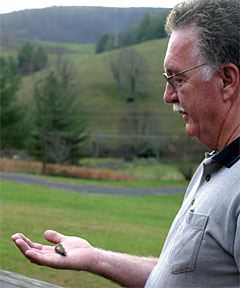 Nonetheless, with the capture of the two hummers at Darrell's plus Vaughn's new one, we had our first-ever "three-bird day" for winter vagrant hummers, and we're grateful to the respective homeowners for allowing us the privilege. We'll likely be going back again to Todd and West Jefferson since both Vaughn and Darrell suspect they may have even more birds. Indeed, Vaughn, Beth, and Darrell-- and Darrell's mom--seem to be doing something right, so that Ashe County appears to be a real hotbed of vagrant hummingbird activity. Now THERE'S a fact the local chamber of commerce might like to imprint on its next batch of winter tourism brochures!
Nonetheless, with the capture of the two hummers at Darrell's plus Vaughn's new one, we had our first-ever "three-bird day" for winter vagrant hummers, and we're grateful to the respective homeowners for allowing us the privilege. We'll likely be going back again to Todd and West Jefferson since both Vaughn and Darrell suspect they may have even more birds. Indeed, Vaughn, Beth, and Darrell-- and Darrell's mom--seem to be doing something right, so that Ashe County appears to be a real hotbed of vagrant hummingbird activity. Now THERE'S a fact the local chamber of commerce might like to imprint on its next batch of winter tourism brochures!
 Students at GLOBE-certified schools may submit winter hummingbird observations as part of Operation RubyThroat and GLOBE. Students can also correlate hummingbird observations with data on abiotic factors, including atmosphere, climate, hydrology, soils, land cover, and phenology. See the
Students at GLOBE-certified schools may submit winter hummingbird observations as part of Operation RubyThroat and GLOBE. Students can also correlate hummingbird observations with data on abiotic factors, including atmosphere, climate, hydrology, soils, land cover, and phenology. See the 


